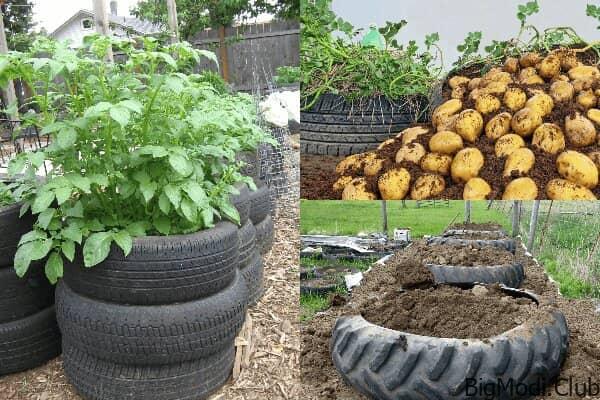If you’re exploring unconventional gardening methods, you might wonder, “How to grow potatoes in tires?” This innovative approach promises a space-efficient solution for cultivating potatoes, especially in limited garden areas. By stacking tires, you can effectively manage soil depth and take advantage of vertical space, but it’s important to weigh both the benefits and potential risks. This guide will delve into the process of growing potatoes in tires, outlining how to prepare, plant, and harvest using this method, while also addressing concerns such as toxicity and overall effectiveness. Whether you’re curious about this technique or looking for a fresh gardening strategy, understanding how to grow potatoes in tires can offer new insights into maximizing your gardening efforts.
How to Grow Potatoes in Tires
Growing potatoes in tires is an innovative and space-efficient way to cultivate this popular crop. If you’re ready to give it a try, here’s a detailed guide to help you get started.
Preparing Potato Chunks
First things first, the potato chunks need to be properly prepared. When cutting your seed potatoes, make sure each chunk has 2 to 3 “eyes”, which are the small sprouting points. This ensures that each piece has the potential to grow into a healthy plant. It’s important to let the chunks dry completely before planting. Depending on the weather, this drying process can take anywhere from 24 to 72 hours. A fully dried surface reduces the risk of rotting when placed in the soil.
Mixing the Soil
Now, let’s talk about the soil. Potatoes thrive in a simple but well-balanced mix. For optimal results, combine 60% backyard soil or topsoil with 40% peat moss. The peat moss helps improve soil texture and retains moisture without waterlogging, providing a perfect environment for potatoes to grow.
Choosing the Right Tires
When selecting tires, opt for small to medium-sized ones. Larger tires will require much more soil, which could become difficult to manage. Smaller tires keep the process more efficient, both in terms of soil usage and overall effort.
Planting the Potatoes
Once your soil mix is ready and tires are selected, it’s time to start planting. Begin by filling the first tire with your soil mixture. Now, place 1 to 2 potato chunks into the soil. While it’s tempting to add more, overcrowding will negatively impact your harvest, so stick to just two chunks per tire. Ideally, place the chunks with the eyes facing upward to encourage proper sprouting.
Building the Tire Stack
As your potato plants grow, it’s time to build your tower. After you’ve planted your potato chunks in the first tire, place a second tire on top and fill it with more soil. When you start to see the potato sprouts poking through the soil in this second tire, it’s time to add a third tire. However, instead of soil, firmly pack straw into this third tire. The potato plants will continue to push through the straw, and you’ll soon have a healthy, growing stack. If you’re feeling ambitious, you can even add a fourth tire, again using straw instead of soil.
Harvesting Your Potatoes
When it comes to harvesting, timing is key. If you’re after new potatoes, keep an eye on your plants as they bloom. About two weeks after blooming, you can remove the first tire. Simply spread out the straw and you’ll find delicious, tender baby potatoes ready for harvest.
For mature potatoes, wait until the plant has fully died after the first frost. Once the plant is dead, wait another two weeks before dismantling the tires, one by one, to collect your fully-grown potatoes. Since potatoes grow along the stem, you’ll find them nestled in the soil and straw layers you’ve carefully built.
Managing the Potato Tower
To make your harvest less messy, it’s recommended to use straw in the top tires instead of soil. The straw keeps things cleaner and makes it easier to access the potatoes when you’re ready to harvest. If you’re growing multiple towers, keep in mind that some homeowners’ associations may not be thrilled with the sight of tire towers in your yard. To avoid any conflicts, consider decorating your towers or surrounding them with a small fence for a tidier appearance.
Pros and cons of growing potatoes in tires
Growing potatoes in tires offers a unique approach to gardening, especially for those with limited space or a tight budget. This method leverages the vertical space in your garden by stacking tires, which can enhance yield and make efficient use of available area. However, like any gardening technique, it comes with its own set of advantages and drawbacks. Understanding these can help you decide if this innovative method is right for you. Here’s a look at both the benefits and potential challenges of growing potatoes in tires.
Pros:
- Space-efficient: Growing potatoes in tires is perfect for small gardens or limited spaces. By stacking tires, you can grow vertically, saving ground space and optimizing your garden layout.
- Cost-effective: Old tires are often free or very cheap, making this method an affordable option for those on a budget. It’s a great way to recycle materials that would otherwise go to waste.
- Easily managed soil depth: As the potato plants grow, you can stack additional tires, allowing for easy “hilling.” This encourages more tuber formation along the stem, maximizing your potato yield.
- Warmth for plants: Black tires absorb heat from the sun, which warms the soil inside. In cooler climates, this extra warmth can promote faster growth, giving you healthier plants earlier in the season.
- Mobility: Tire stacks are easy to move around, especially if they are kept small. This flexibility allows you to reposition your potato towers based on sunlight or space availability in your garden.
Cons:
- Toxicity concerns: One of the main drawbacks of using tires is the potential for chemicals, like petroleum byproducts, to leach into the soil. This raises concerns about the safety of growing food crops in such an environment.
- Breakdown of materials: Over time, tires exposed to the elements will degrade. As they break down, they may release harmful substances into the soil, which could affect both the plants and the soil’s long-term health.
- Aesthetic issues: While practical, tire towers can be visually unappealing. Some gardeners or neighbors might find them unattractive, and certain homeowners’ associations may even prohibit their use for aesthetic reasons.
- Heat risk in hot climates: Although the heat-absorbing property of tires is beneficial in cool areas, in hot climates, it can become a disadvantage. Excessive heat could overheat the soil, potentially damaging or even killing your potato plants.
- Limited root space: Tires can limit the root space available to your plants. While stacking additional tires provides more room for roots to grow, it requires careful monitoring to ensure the plants have adequate space to thrive.
Is growing potatoes in tires toxic
When considering whether to grow potatoes in tires, one critical question arises: Are these tires safe for growing food? This debate revolves around the potential toxicity of using old tires as planters.
Toxicity Concerns
Tires are manufactured with various chemicals and metals, some of which are not safe for human consumption. Over time, these materials can break down and leach harmful substances into the soil and potentially into the food crops grown within. This gradual erosion raises concerns about the safety of using tires in gardening.
Degrading Process
The degradation of tires is a slow process that unfolds over several decades. While this means that the leaching of chemicals occurs over a long period, the exact levels of chemical release are not well-documented. This lack of precise data contributes to the uncertainty surrounding the safety of using tires for growing edible plants.
Off-Gassing
New tires are known for their distinctive odor, which results from the release of volatile chemicals. Most of this “new-tire smell” occurs while the tire is still in use on a vehicle. By the time tires are repurposed for gardening, most of this off-gassing has already occurred, though some residual chemical release may still happen.
Debate
The debate over using tires for gardening involves two main perspectives. On one hand, repurposing old tires can be seen as a responsible and eco-friendly way to manage waste, offering a practical solution for those looking to grow plants in limited spaces. On the other hand, concerns about potential health risks from chemical leaching, even if minimal, lead many to consider safer alternatives for planting.


